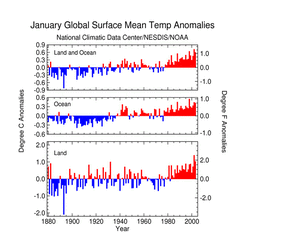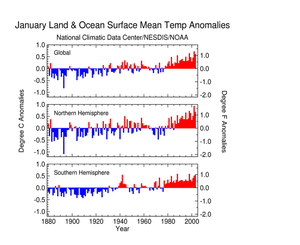Global Highlights:
- Global average combined land and sea surface temperature was
the third warmest for January 2003
- Temperatures were much above average across western U.S,
Alaska, Canada and southeast Australia with below average
temperatures across eastern U.S., eastern Mongolia and
Scandinavia
- Precipitation during January was above average across much of
Europe and northern Africa as well as parts of southeast China,
with drier than average conditions over northern Brazil, most of
the U.S. and the eastern half of Australia
|
|
Contents of this Section:
|
| The data presented in this
report are preliminary. Ranks and anomalies may change as more
complete data are received and processed. The most current data may
be accessed via the Global Surface
Temperature Anomalies page. |
Introduction

larger
image
|
January temperature
anomalies calculated from the Global Historical Climatology Network
data set of land surface stations using a 1961-1990 base period
also show above average temperatures throughout Canada, Alaska and
much of the western United States. Monthly temperatures were
4-6°C (7.2-10.8°F) above the mean. Notable cool anomalies
were present throughout the eastern U.S., northern Europe, and
parts of southern Asia where monthly temperatures were as much as
3-6°C (5.4-10.8°F) below average. |
Temperature
January
- For January 2003, the global average land and ocean surface
temperature was 0.60°C (1.08°F) above the 1880-2002
average, ranking as the third warmest January in the period of
record
- The warmest January occurred in 2002, with an anomaly of
+0.72°C (+1.30°F)
- Globally averaged land temperatures were second warmest on
record, or 1.03°C (1.85°F) above the long-term mean
|

larger
image
|
- January 2003 temperatures averaged across the Northern
Hemisphere were third warmest on record, or 0.68°C (1.22°F)
above the long term mean
- Temperatures averaged throughout the Southern Hemisphere were
fourth warmest, or 0.53°C (0.95°F) above average
|

larger
image
|
Precipitation
- During January 2003, much above average precipitation fell
across most of Europe into northern Africa, as well as southern
Brazil and parts of southeast China
- Below average precipitation was observed across most of the
U.S., the eastern half of Australia and northern Brazil
- Additional regional analysis can be found on the Global Hazards
page
|
 larger
image
larger
image
|
References:
Peterson, T.C. and R.S. Vose, 1997: An Overview of the Global
Historical Climatology Network Database. Bull. Amer. Meteorol.
Soc., 78, 2837-2849.





 NOAA's National Centers for Environmental Information
NOAA's National Centers for Environmental Information